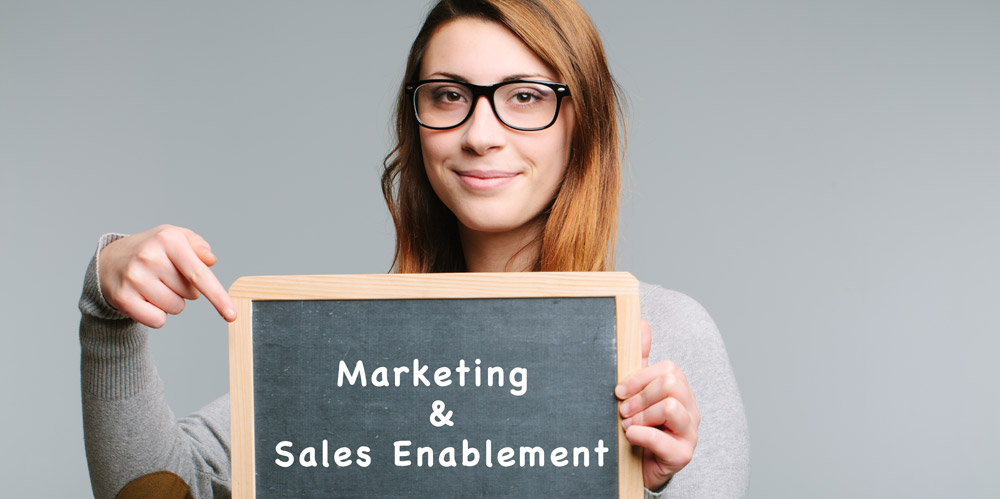
Sales Enablement Best Practices-How Sales Enablement Benefits All Reps
Sales reps are constantly coming up against challenges and problems as they attempt to close deals and drive revenue. From wasting nearly a third of every day searching for or revising content to feeling frustrated at the lack of available content marketing training materials, sales reps have a lot to deal with in a day—and not a lot of time. If these problems sound familiar, know there’s a better way. By making an organized, strategic push toward sales enablement in your business, you can drastically reduce the problems your sales reps routinely battle and start to work toward better productivity and increased revenue.
Sales Enablement: Solving Real Problems for Sales Reps
Sales Enablement Starts In House
There is no single answer for what makes sales enablement effective. It’s about applying the general principles to find the solutions that address your specific problems. Therefore, one of your biggest assets is your group of successful sales reps.
These people are finding ways to genuinely connect with prospects, shorten the sales cycle, and close deals. If you’re thinking about building out a full sales enablement program, step one should be going to your top-performing reps and figuring out how they do what they do. One goal of sales enablement is to create a replicable, teachable system to all reps (new or otherwise), and your current performers possess much of that necessary knowledge base.
10 Benefits of Implementing a Sales Enablement Program
1. Increase Sales Rep Quota
A best-in-class company is twice as likely to use a sales enablement program, and best-in-class companies enjoy 50 percent higher quota attainment than other companies.
2. Use Sales Reps Time More Efficiently
A sales rep’s time is extremely valuable, and any minute not spent on core selling is a minute not spent actively closing deals and increasing revenue. The average sales rep spends about 30 percent of the day looking for content or revising content to be more relevant to the prospect. No company can expect positive results and growth when nearly one-third of a sales rep’s day is needlessly spent.
Currently, on average about 65 percent of created content is never even used (37 percent is simply unusable or irrelevant, and 28 percent isn’t findable). Sales enablement can help with both these issues.
In terms of irrelevant content, sales enablement can implement the framework that gets your marketing team creating content that actually helps in the sales cycle. An estimated $2.3 million is lost in enterprise organizations due to underused or unused content. However, when your marketing team writes content that specifically addresses your company’s buyer personas at the different stages of the sales cycle, this drastically increases the likelihood that the content will actually be relevant and helpful to your sales reps. These processes limit the time (and money) spent working hard on content that will never be used.
Two, implementing an organized, intuitive content system, where sales reps can quickly and easily find what they need, will stem the tide of wasted time searching through file after file to find that one desired piece of content. Sales enablement, when done right, means your reps spend less time doing this kind of administrative work and more time selling.
3. Help Sales Reps Close Deals Faster
As more people have become involved in corporate buying decisions, the length of the sales cycle has increased exponentially. Creating hyper-targeted content that truly speaks to the buyer persona’s barriers and problems can quickly address those issues and efficiently lead that persona to the next stage. The faster your sales reps can close, the more deals (and money) they can generate.
Even if a rep has to deal with multiple personas in a particular deal, an organized, strategic content system will have whatever content is needed, and it will be quickly and easily at the rep’s fingertips.
4. Focus On the Digital Age
Sales enablement is largely based in selling in the digital age. It helps sales reps know how to be successful with the kinds of leads they encounter now, which do largely come through a company’s website.
5. Align the Sales Team and Marketing Team (and everyone else)
Proper alignment between marketing and sales is key to a successful sales enablement program. But it’s not just marketing and sales that need to be on the same page. Sales enablement should be treated as a business within a business, which effectively ensures all departments are working toward the same goal: doing everything possible to increase the efficiency and effectiveness of the sales team in order to up revenue.
6. Assist in a Consultative Selling Approach
For a sales rep to be successful today, he or she needs to provide real value to the prospect. That means doing more than just answering a few surface-level questions about the company or product. It means taking a more consultative approach: learning about prospects and their challenges and finding creative solutions to address those. The more targeted and relevant the content, the more value it provides to the prospect. And when a prospect perceives a sales rep as truly valuable, it builds credibility and trust in that person, which leads to a better opportunity to close that deal.
7. Provide Helpful Training
Sales enablement is still relatively new, and many sales reps find themselves frustrated at the lack of helpful training material made available to them. Essentially, their companies tell them to sell in this new way, and then they don’t provide the road map to get them there. If a rep doesn’t know where to find content, doesn’t know how to talk to a specific prospect, or doesn’t understand that prospect’s core challenges going in to a conversation, there’s little chance the rep will build that requisite trust with the prospect.
A good training system, however, will inform the rep about the sales enablement processes, explain the reasoning behind those processes, and educate about how logistically to use the content system.
Good training will do more than just provide a tutorial on how to log in to a content system. It will explain the underpinning logic of the buyer’s journey and how content can play an effective role in the buying decision. It will also explain why the marketing team is creating content in a specific way. When sales reps see this whole picture, the processes make more sense, and there tends to be much greater buy-in and follow-through.
All this leads to more informed, more insightful sellers. Training can show reps how to deal with a variety of personas in a variety of situations—and still have success. These skills translate well to any subsequent selling position.
8. Provide Better Opportunities to Prospect Clients
When sales reps understand the whole picture, they can potentially go and find viable prospects through online channels, such as LinkedIn.
9. Experience Less Frustration
Not reaching a quota is stressful and frustrating for any sales rep. Nobody likes working hard every day only to see minimal results. When reps have this increased opportunity to reach and exceed quota, much of the frustration associated with the job can disappear.
10. Improve Selling—Across the Board
Sales enablement isn’t about teaching a rep to close a deal in one limited situation. It’s about how to have success in any given prospect interaction. Sales enablement helps reps understand the core messaging for a variety of buyer personas—no matter what stage of the buyer’s journey. They also learn how to qualify and deal with a number of objections. All this creates a more insightful, valuable sales rep, and an organized system ensures the content that rep needs is never more than a few clicks away.
For more information about how sales enablement can benefit every rep within a sales team, please feel free to contact a representative of Brand Fuzion today!
Learn how to increase marketing and sales productivity by developing a predictable, gowning sales pipeline through isales enablement.


Recent Comments